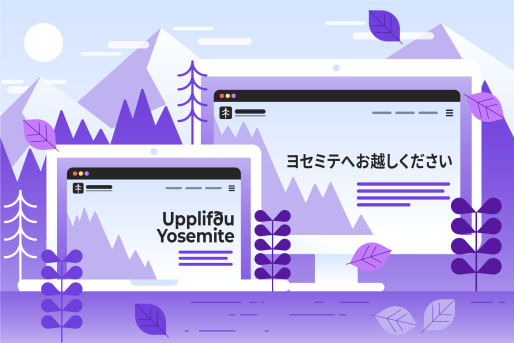Matt Grech
Content Marketing ManagerSmartling
No matter how advanced technology becomes, the human element will always be the core of how we work, how we communicate, and how we connect with the world.
There will always be that desire for a personal connection, and a human experience. It's why front desk clerks still stand at the ready at hotels, even though the majority of booking and arranging happens online.
It's why we still buy cars in a dealership, even though you can actually research, haggle and order your next car online.
Even when buying online, customers still want to feel that personal, human connection -- especially when they’re buying from a brand in a completely different country. And that’s only achievable when a business is speaking their language. That’s exactly why localization is so important.
Especially during this time of uncertainty, when shopping, communicating and collaborating has entirely shifted to digital experiences, website localization has become an even stronger competitive advantage.
What is Website Localization?
Website localization is the process of adapting your digital content for a different language and culture.
The concept isn’t just translating text and leaving it at that, but rather adapting the entire experience to a resonate with a new audience. This would begin with translation, but should also include:
- Translating product information
- Tailoring product offerings
- Adapting promotions and sales
- Converting currencies
- Providing shipping options in multiple regions
- Providing direct support in a customer’s language
- Adhering to local legal and tax regulations
By creating an experience that feels native to the user, your brand will foster that human connection that buyers seek. Customers should feel like the website was created with their culture, their needs and their language in mind, not just an extra afterthought.
And a big part of adapting your experience will come back to offering the right solution or service, at the right price point, at the right time.
For example, an American furniture company tailoring their wood and style selection online for Italian buyers, or a clothing eCommerce retailer swapping out product images and models from American styles to current Japanese trends.
It also wouldn’t make sense for that eCommerce clothing retailer to sell the same summer clothes marketed towards Americans to Australia in May, when the southern hemisphere is just starting winter.
Website localization drives growth
It almost goes without saying that website localization can drive significant growth for your brand by unlocking entirely new markets.
When we took a look at five major eCommerce retailers, website localization and language accessibility played a direct role in driving the growth of four brands in the last five years; including 149% growth for ASOS, an entirely eCommerce based retailer.
The idea is simple in concept: by opening up your website to new markets and new locations, and then tailoring your messaging, offerings, solutions and experiences to that culture, language and demographic, your brand can bring in new users and power new businesses.
Build trust with authenticity
Make no mistake - global consumers today know the value of their money, and comparison shopping can be achieved in a matter of seconds with a few clicks.
The "race to the bottom" of cost-cutting only goes so far before profits start to decline noticeably; the real point of differentiation needs to happen well before the checkout page.
Even if your site design is clean and tight, low quality translation can instantly drain trust out of the equation. Don't believe it has much of an impact?
Consider which you'd choose, if faced with buying from two product sites that were otherwise identical in style and price: the one with fluent product descriptions or the one that has mistranslations and turns of phrase that don't sound correct?
By translating your content, your brand establishes an authentic connection with the user. Your website feels tailored and designed for that user's language and culture, and it feels like they're shopping from a native experience, building trust.
Translating user generated content is a great example of how brands can build authenticity. Users are hearing directly from their peers, learning their real world experience.
Ensure brand cohesion
The "feel" of your brand is extremely important to gaining a foothold in the international market: chances are, you've worked hard to establish it in the minds and hearts of your target audience domestically.
It's that experience that your brand has become known for that keeps users coming back, shoppers filling their carts, and companies relying on your services.
Localization accounts for spotting and editing out potential faux pas, such as domestically tame ads that may come across overtly sexual to a conservative country, or promoting a product to be used in a way that would be nonsensical or offensive to the locals.
Prioritize content and start small
The beauty of localization is that it doesn’t have to be an all-in scenario. Brands can ease their way into new markets by strategically translating high priority content, or localizing specific aspects of their experience to “test the waters.”
And you can even start with what you already have, maximize your existing investment in content.
Simply refer to your metrics, pick your strongest-performing (traffic, clicks, etc.) pieces of content or pages, highest selling items, or even locations where traffic seems to be climbing, and prioritize that for localization.
You'll enjoy a head start by working with proven content, and your international customers and clients will see your best contributions immediately, bolstering both trust and conversion rates.
You've already put the time, work, and/or money into having your original content created, so don't let it sit around like a roommate that skips on the rent.
Make it work as hard as possible for you by having it localized. As a bonus, once the localization is complete, that content can then be used for foreign language voice overs, video content captioning, and more, delivering even more value for your initial content spend.
Website Localization is a key differentiator in 2020
Opportunity doesn't knock, it goes straight to your website and let's be honest here: browser plug-ins and apps aren't going to impress it.
And we’re only going to continue to see deluge of digital traffic for the foreseeable future, meaning this is an amazing opportunity for brands to stand out among the crowd, and meet customers where they already are.
Remember: you don't have to speak the language fluently to achieve marketing that does. localization is the key to building a language bridge between your business and your customer, no matter how many miles apart you happen to be.









